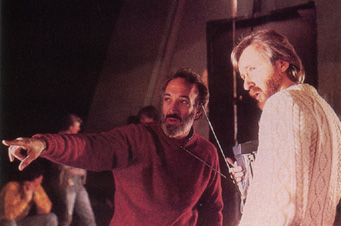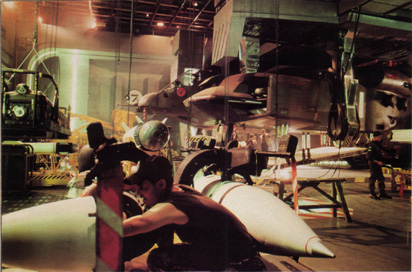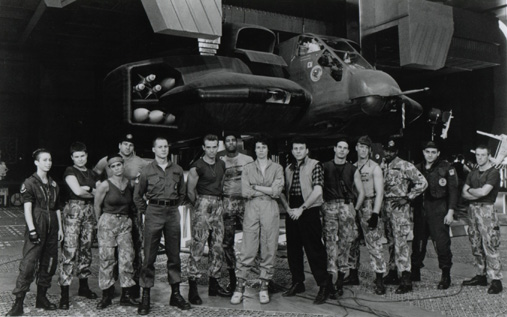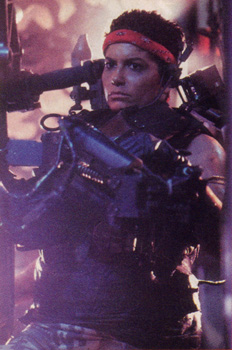 
Life Among the Aliens
Ripley returns with a new team to the now-colonized "ALIEN" planet to seek and destroy an entire horde of acid-bleeding, metal jawed movie monsters.
By Adam Pirani
 
Imagine being trapped in an enclosed space, stalked by a relentless biomechanoid who is killing your friends,
one by one.
That was ALIEN.
Now, envision the return of the biomechanoid parasite in numbers. The terror is multiplied. The field of battle is enlarged.
This is ALIENS.
Acton Power Station, west London: it's the movie's first week of lensing. All sets are closed, but STARLOG has exclusive access to witness the filming of ALIENS and to interview key production personnel. Acton is the movie's sole location: a disused electricity generating plant which burned coal from 1958 to 1983 before becoming obsolete for economic reasons.
It's remarkable how easily a redundant piece of mid-20th Century engineering has been transformed into a futuristic "atmosphere processing station." The planet Acheron is being terraformed, and in the long term, the processing station will generate an atmosphere that will make spacesuits unnecessary for future generations of colonists.
If there is a "long term."
  Because "Acheron" is the new name for the alien planet encountered by the U.S.C.S.S. Nostromo in ALIEN. The Nostromo's sole survivor, Ripley, has been in a hypersleep capsule drifting in deep space for some years. By the time she is discovered, a group of unsuspecting space engineers and their families have already begun living and working on Acheron. Because "Acheron" is the new name for the alien planet encountered by the U.S.C.S.S. Nostromo in ALIEN. The Nostromo's sole survivor, Ripley, has been in a hypersleep capsule drifting in deep space for some years. By the time she is discovered, a group of unsuspecting space engineers and their families have already begun living and working on Acheron.
Huge mirrors at a 45-degree angle on the power station's first floor indicate the presence of the film unit. The mirrors are reflecting light from huge lamps up through two levels of grillework flooring. Climb up two flights of clanking metal stairs and the unit is there, more than 30 people crowded into a small space, working, talking, filming.
As the rest of the crew prepare the shot, director James (The Terminator) Cameron is conferring with some actors. They are dressed in green military uniforms and helmets, carrying heavy weaponry. The set is a dark, narrow walkway, flanked by machinery which is overgrown with a strange biomechanical structure. Part of the machinery has been covered by sheeting, for a side-angle shot in which a flamethrower is fired, off-camera, in its direction.
Now, technicians check small gas jets which send controlled flames up through the floor grille on one edge of the walkway. As the green-clad actors get in place for the next shot, their friendly conversation dies down. The cameras roll. The actors, suddenly in character, are tense, jumpy, glancing fearfully from side to side. The, gas jets shoot out fire, aftermath of the flamethrowing. Adrenaline and sweat are in the air.
"Talk to me, Hudson!" a tall, black trooper shouts out. There is an answer, but the atmosphere of fear persists, the presence of some alien menace nearby seems a certainty. Until, finally, "Cut" is called and the scene ends.
Story Cracker
  "The Ridley Scott ALlEN was, in a sense, a gothic horror film - Ten Little Indians in a confined space. It was a haunted mansion kind of experience, and you knew there was an evil lurking there, and the cast members were eliminated one by one," says ALIENS producer Gale Anne Hurd. "Well, we didn't want to repeat ourselves, because this is not a remake. We've opened it up, and ALIENS is really more of a combat film than a film about an evil lurking in the shadows. There's far more action, more of an adventurous, exhilarating experience than I think people feel the first film evoked."
"The Ridley Scott ALlEN was, in a sense, a gothic horror film - Ten Little Indians in a confined space. It was a haunted mansion kind of experience, and you knew there was an evil lurking there, and the cast members were eliminated one by one," says ALIENS producer Gale Anne Hurd. "Well, we didn't want to repeat ourselves, because this is not a remake. We've opened it up, and ALIENS is really more of a combat film than a film about an evil lurking in the shadows. There's far more action, more of an adventurous, exhilarating experience than I think people feel the first film evoked."
This "continuation" of ALIEN after seven years came about because of Hurd and Cameron's success with The Terminator (STARLOG # 88). The rights to make an ALIEN sequel were in the hands of producers Gordon Carroll, David Giler and Walter Hill (STARLOG #24), and 20th Century Fox.
"Walter and David have a company together called The Phoenix Company," Hurd explains. "They had a project which they wanted Jim to do - a futuristic updating of Spartacus. They had read the Terminator script and were very impressed. As I was busy putting together the pre-production on Terminator, Jim met with them, was pitched the Spartacus idea and didn't immediately respond to it. So, he asked if there might be any other projects they were considering.
"They said, 'Well, there is the sequel to ALIEN.' Jim said, 'ALIEN was one of my favorite films of all time, and I would really love to have a shot a cracking that story.' Because, at the time, it really hadn't been cracked. No one had come up with an approach that was satisfactory to all the various creative individuals involved."   Cameron's script - in which Ripley returns to the alien planet with a troop of U.S. Colonial Marines - meant the "long-awaited sequel" became a movie "coming soon to a theater near you." With Sigourney Weaver signed to reprise her role as Ripley and a new bigger cast including Michael Biehn as Corporal Hicks, Paul (Beverly Hills Cop) Reiser as Burke, Lance (The Right Stuff) Henriksen (STARLOG #78) as Bishop, Bill (Weird Science) Paxton as Private Hudson and young newcomer Carrie Henn, production got underway at London's Pinewood Studios. Cameron's script - in which Ripley returns to the alien planet with a troop of U.S. Colonial Marines - meant the "long-awaited sequel" became a movie "coming soon to a theater near you." With Sigourney Weaver signed to reprise her role as Ripley and a new bigger cast including Michael Biehn as Corporal Hicks, Paul (Beverly Hills Cop) Reiser as Burke, Lance (The Right Stuff) Henriksen (STARLOG #78) as Bishop, Bill (Weird Science) Paxton as Private Hudson and young newcomer Carrie Henn, production got underway at London's Pinewood Studios.
Biehn, who portrayed The Terminator's Kyle Reese, the rebel warrior from the future, is enjoying working with Cameron again, though he notes, initially, "I had some reservations about the character. When they called me, I felt Hicks was too much like Kyle Reese. And I think Jim originally felt that too. Hicks is a quiet, stoic, very heroic, and I had just done that in Terminator with him, so we talked about finding ways to make this character different."
One thing that hasn't changed between Terminator and ALIENS is the physicality of Biehn's role. "Our wardrobe is extremely heavy, and I carry a weapon that weighs about 65 pounds," the actor says. "It's very, very heavy - I mean, you can pick it up and say, 'OK, this is pretty heavy,' but then you're dragging it around and running with it all day long, among dirt and wind machines and rain--! We worked in these sort of vent-like things, so we were always squatting down, running through vents, and diving, jumping and fighting.
"You come home from a day's work, and you've got pinches here and bruises there, a scratch here and a cut on your hand, and if you look down at your body, there are red markers all over it, and you're just beat. When you're an actor, you do scenes over and over again, 12 or 13 times. And if it's an action movie, and you're supposed to go jump over the fence, well, you go jump over it. It's kind of easy the first time. The second time, it's not quite so easy. By the time you're on your twelfth take, you're running up and falling over it. It can be pretty difficult.
"One thing about working with Jim Cameron that I like, is that I trust him 100% always to be aware of the safety of the crew and the actors. Working on The Terminator and ALIENS, there was a tremendous possibility of somebody getting hurt because there's fire, explosions, car chases, fights, slipping, falling, jumping, and stunts galore. And nobody has ever had any more than bruises, scratches, little cuts here and there. If anything ever isn't quite right, Jim'll be the first one to step in and be interested in the welfare of the people he works with which is something that I don't' think some other directors can claim."
Lance Henriksen also appeared in The Terminator, as police detective Vukovich. His ALIENS character has presented him with a different sort of challenge: he portrays Bishop, an android. "I was faced by a couple of hard acts to follow," the actor says. "I saw Blade Runner, and to me Rutger Hauer's work in that was almost definitive.
 
"I thought, 'My God, this guy--.' It was just beautiful, it was a beautiful piece of work. When I first saw it years ago, it was burned into my mind, it was such a glowing performance. And then I think I saw others play androids later: Klaus Kinski in Android and Ian Holm (STARLOG #99) as Ash in the original ALIEN.
"And then I was faced with a big problem. I started figuring out, 'Now, how am I going to approach this, what aspects of this character - a mechanical person, a robot-are things to which I can really relate?'"
The Model Tracker
Pinewood Studios: M Stage. FX make a significant contribution to the ALIENS storyline. While the main unit shoots elsewhere, lensing continues on two stages being used exclusively for visual FX by the LA Effects Group, which also worked on Commando and Jewel of the Nile. Filled with thick, grey, fog-like smoke, M stage's visibility is only about 10 feet, but muted lights beyond suggest that the small stage extends into infinity.
Attention among the FX crew is focused on a miniature set built on a ramp. The set is the floor, walls and ceiling of a lengthy corridor within the atmosphere processing station. Approximately 18 inches high, four feet wide and 25 feet long, the corridor structure is built from wood. The ramp that it rests on is at a 30-degree angle to the floor, itself supported by sturdy scaffolding. At its highest point, the ramp is about 15 feet above the floor; at its lowest, it touches the ground. [Nathan's Note: The set-up can be seen in an episode of the TV show "Movie Magic," along with some filming bits.]
  Looking up through the corridor from floor level, the utility of the acrid fog is apparent. Suffused with smoke, the meticulously detailed corridor interior seems to have no dimension; atmospheric lighting gives the impression it could be any size. Looking up through the corridor from floor level, the utility of the acrid fog is apparent. Suffused with smoke, the meticulously detailed corridor interior seems to have no dimension; atmospheric lighting gives the impression it could be any size.
The camera operator is preparing for the next shot. He wears a track suit, light crash helmet, knee pads and elbow pads. The camera is fixed on the front of a six-foot-long, sleigh-like "dolly" mounted on trolley wheels.
For this shot, the camera operator will lie down on the foam-covered dolly, which will be released inside the 18-inch-high corridor, from the top of the 25 foot long angled ramp. The wheels are locked off so the dolly can only travel in a straight line. But when it reaches the bottom, the dolly will have considerable velocity. Four or five crew members are standing just past the ramp's bottom to catch the dolly - and the operator.
What the camera will actually be filming is a miniature APC, an Amoured Personnel Carrier used by the Colonial Marines. It is a one-twelfth scale model of an APC which was used at the Acton location. With gigantic wheels and thick amour plating, the full sized version was adapted from a vehicle used to tow jumbo jets along runways.
The FX crew is ready. The camera is set to film at 48 frames-per-second, double the normal, to achieve the best looking speed. Form the inside of the top of the ramp, the dolly is released, and a moment later, so is the miniature APC. Now, as he lies face down on the dolly, which is rolling backwards and accelerating very fast, the operator, looking through the camera eyepiece, must keep the weaving APC in shot and in focus.
There is a sudden crashing noise, several expletives, and the operator on his dolly rockets out of the ramp's bottom and is caught and brought to a halt.
"What happened?"
"Are you OK?"
More Expletives.
It takes only a few moments to discover that the operator is all right. He explains what happened-the miniature APC hit the camera lens. It must have been released to soon. It takes only a few moments to check that neither piece --- the hand-crafted model nor the expensive camera - is damaged, but it will take more time to prepare the shot again.
Despite these occasional delays, LA Effects line producer Suzanne Benson is pleased with her group's progress on the movie so far. "This is a very complex project," she notes. "We're doing about 150 special photographic effects shots, and I think, for the projects size, it's going extremely well." In doing miniature FX, optical work and motion control shots, retakes and problems are inevitable, she says. "Sometimes, you can't help it."
The LA Effects Group departed the project late in filming through its creative personnel continued working on the movie through its completion. 'ALIENS' other two FX units are also based at Pinewood Studios. John (A View to a Kill) Richardson is supervising mechanical FX, and Stan Winston, another Terminator veteran, is handling creature FX. The moviemakers' choice of FX teams was simple. "Whenever you go into a challenging proposition, you try to surround yourself with people that you know will deliver what you want," producer Hurd explains. "Stan Winston worked out extremely well for us on Terminator, and we knew that the creative rapport between Stan and Jim was terrific. And when you have a little pre-production and planning time as we did on this film, you need to communicate in a verbal shorthand. Two of the key creative people in LA Effects are Robert and Dennis Skotak. We all worked together on Battle Beyond the Stars for Roger Corman, and Him, Robert and Dennis also worked together on visual FX for Planet of Horrors and Escape form New York."
Facehugger, chestburster, full-size alien - in ALIEN, these creatures were principally designed by H.R. Giger and realized by Carlo Rambaldi and Roger Dicken. Following their work for ALIENS is Stan Winston, whose wide create FX and makeup experience includes work on Starman (The stretching baby), The Thing (Dog-Thing effects) and Something Wicked This Way Comes (Mr. Dark's disintegration). Winston and his crew face a daunting schedule. "is the biggest project I've ever been involved with, in the scale of my work," he says. "'Not the biggest film, but without a doubt, the biggest, most ambitious project that I've ever been involved with. It was more production value than movies twice the budget."
Movie Maker
  Pinewood Studios: The "med-lab" set. The shot is in progress. An alarm is blazing, red lights are flashing; Sigourney Weaver protectively clutching a little girl, is being drenched by sprinklers. The camera is encased in plastic covering, and crew members on set wear green or yellow raincoats.
Pinewood Studios: The "med-lab" set. The shot is in progress. An alarm is blazing, red lights are flashing; Sigourney Weaver protectively clutching a little girl, is being drenched by sprinklers. The camera is encased in plastic covering, and crew members on set wear green or yellow raincoats.
Jim Cameron, just outside of water range, in black leather jacket, pink shirt, blank trousers and shoes, has a viewfinder hanging round his neck. But he's not looking through it, or looking at the set - he's watching the action on a miniature black-and-white video monitor with a three inch screen which shows the camera's viewpoint.
The blaring, flashing and drenching continues for mere seconds. Then, in the shadows, Ripley whacks against some small, indeterminate shape. She screams in surprise. End of shot. Cut.
"We'll probably take an entire beef liver and throw it on a piece of concrete to get the sound," Cameron tells Weaver.
As Ripley, Weaver is the star of ALIENS - in front of the camera. Behind the camera, the star is Cameron - writer, director, and the creative center of the entire production. As with The Terminator, Cameron's tireless inventiveness is inspiring his crew to produce extraordinary work themselves.
"What we're doing is almost the impossible," says Stan Winston. "I can say this from having been through two films with Jim now - if you're going to work with Jim on a film, you must accept the fact that he's going to ask for, if not demand, that which is next to impossible. It's very, very difficult, but it makes for something very special ending up on the screen. He's not an easy person to work for - to work with, but this is the second time in my career, after Terminator, that I have felt completely secure that the film will be a hit. ALIENS is that good."
Adds Gale Anne Hurd, "Jim, in addition to being very good at verbal images, is great at visual images, and he has the advantage of being an artist - and a very good artist. His design work prevades the film. I don't' think there's a single frame of this movie that doesn't have Jim's signature on it. He was involved in every step of the process: he wrote the screenplay, he designed, or had a design influence, on absolutely every piece of equipment, every set, every special effect, every alien in the picture."
Actor lance Henriksen puts it another way. "I've been on some fast-moving flicks and I've never seen anything like this one," he asserts. "You're not going to believe this movie when you see it. All I know is that people had better have seat belts when they see ALIENS - I'm telling you, they'll need 'em. They're going to need something to held 'em in their seats."
|

